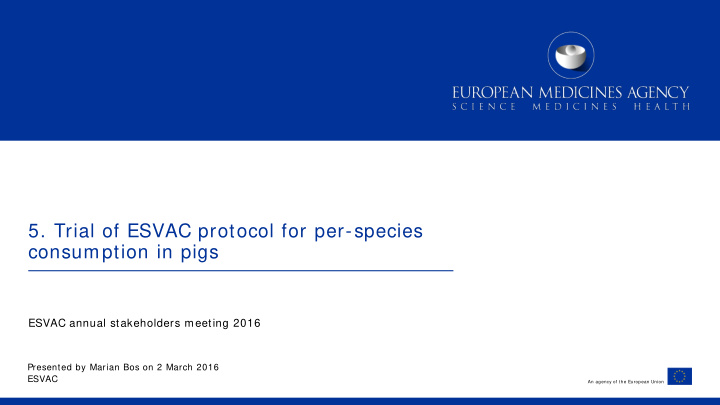



5. Trial of ESVAC protocol for per-species consumption in pigs ESVAC annual stakeholders meeting 2016 Presented by Marian Bos on 2 March 2016 ESVAC An agency of the European Union
Outline • Background • Objectives of trial • Protocol tested • Results • Concluding remarks • Next steps 5. Report pig trial
Background • EC has requested EMA to provide approach to estimate antimicrobial consumption in at least pigs, cattle and poultry • It was decided to start by collecting data in pigs • Therefore required variables needed to be identified and protocol and template developed • Protocol and templates were subsequently tested during trial 5. Report pig trial
Objectives of the trial To identify: 1. extent to which variables required to analyse and report harmonised and standardised data on consumption of antimicrobials (including medicated feed) and pig farm population were available; 2. if all required information on treatments with medicated feed could be captured with proposed variables or if additional variables were required; 3. applicability of templates; 4. feasibility of proposed system; 5. structure of pig industry in participating MSs – i.e. numbers and types of farms, such as farrow-to-finish or finisher farms. 5. Report pig trial
Protocol tested • Convenience sample of 5 farrow-to-finish farms per country • Data on all antimicrobials administered during calendar year (numerator), from • Health records/ treatment log books • Delivery notes • Invoices • Prescriptions/ veterinary practice records • Data on pig farm population (denominator) • Number of pigs produced per calendar year • Average number of pigs present per category per day • Data on national pig farming structure • Short feasibility survey conducted on resources needed to collect and provide data 5. Report pig trial
Results • 46 farms enrolled (42 farrow-to-finish) from 10 countries • BE, CZ, DE, ES, FI, FR, IT, NL, SK, UK • ~ 6,700 records • Data sources used: • Health records/ treatment log books: 21 farms • Prescriptions/ veterinary practice records: 9 farms • Delivery notes: 5 farms • Invoices: 1 farm • Combination of sources: 9 farms • Treatments with medicated feed mainly from prescriptions/ practice records 5. Report pig trial
Results (cont.) • Quantity of active substance consumed could be calculated for 99.7% of records • Pig category treated clearly identified for 78% of records • But hardly/ not in delivery notes or invoices • Pig farm population data complete/ available for 26 farms • Only number of pigs produced: 8 farms • Only number of pigs present: 8 farms • Not available or incomplete: 12 farms • Majority of pig farms in participating countries farrow-to-finish, farrow-to-wean or wean-to-finish 5. Report pig trial
Results feasibility • Wide variety in resources needed to collect and provide data needed • Median time needed to fill in “ESVAC On Farm” template: 4 hours • Median time needed to fill in “ESVAC Pig” template: 12 hours • Least resources needed in trial when data extracted in automated manner from continuous data collection system • With experience less time needed to collect data • Recommended to enable provision of aggregated data (i.e. all treatments with one VMP within a farm summarized and reported in one observation) 5. Report pig trial
Concluding remarks • Possible for ESVAC to define those parameters that need to be measured per farm: • For antimicrobial consumption to be measured in standardised units • By means of either on-farm data collection or data on veterinary prescriptions • Pig farm population data: • Challenging to collect but essential to standardise consumption using an agreed denominator • Further work ongoing with ESVAC species EAG to clarify best option for establishing harmonised denominator 5. Report pig trial
Concluding remarks (cont.) • Data at farm level (i.e. per species) sufficient for ESVAC to e.g. analyse trends per species • Data by production stage (pig category) provides more detailed understanding • Not possible for all MSs to use one data source or one form of consumption data • Data sources heterogeneous but relatively comparable output • For analysing and reporting harmonised data at EU level: • MSs should ensure that actual amount of active ingredient consumed and denominator are calculated according to ESVAC recommendations • Data quality control system needs to be put in place at farm and national level 5. Report pig trial
Next steps • Report on trial in pigs to be published on Agency’s website, tentative deadline April • Publication of revised guidance (and template) on Agency’s website for public consultation • ESVAC in collaboration with the EAGs will initiate discussions with MSs and with EC how guidance could be used as basis for harmonised data collection throughout EU 5. Report pig trial
Acknowledgements The participating Member States Belgium, Czech Republic, Finland, France, Germany, Italy, Netherlands, Slovakia, Spain and United Kingdom are gratefully acknowledged for assisting the development of the protocol and templates for the trial in pigs and the collection of data. Furthermore, Loris Alborali, Patrick Butaye, Claire Chauvin, Julie David, Inge van Geijlswijk, Enrico Giacomini, Katherine Grace, Rüdiger Hauck, Judita Hederová, Henriette Helin-Soilevaara, Bart Hoet, Martina Ihnátová, Roswitha Merle, Miguel A. Moreno, Gérard Moulin, Alessandra Perrella, Lucie Pokludová, Liz Redmond and Hannah Reeves are thankfully acknowledged for providing the data and valuable comments during the revision of the protocol, templates and report. 5. Report pig trial
Thank you for your attention Further information ESVAC@ema.europa.eu European Medicines Agency 30 Churchill Place • Canary Wharf • London E14 5EU • United Kingdom Telephone + 44 (0)20 3660 6000 Facsim ile + 44 (0)20 3660 5555 Send a question via our w ebsite www.ema.europa.eu/ contact Follow us on @EMA_ New s
Recommend
More recommend